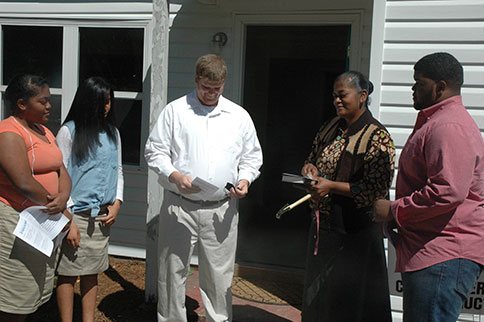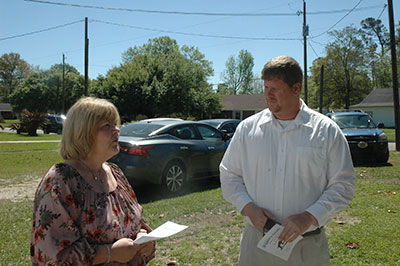
Kim Fountain of Atmore and her three children celebrated on March 31 a new chapter in the history of their family and in the history of Escambia County Habitat for Humanity.
When Fountain accepted the keys to 507 East Craig Street, which is the first Habitat house erected within the city limits of Atmore, from local Habitat board president Jason Newby, she became a homeowner for the first time.
“It’s a big day for her; it’s a big day in our family’s history,” said her son, Marquez, one of three children who will share the home with their mother. Marquez’s sisters, Breoea and Makayla, will also live in the family’s first non-rented home.
“This is the first home she’s ever owned,” said Fountain’s sister, Sheneilia Hartley. “I am very proud for her.”
Lisa Tindell, executive director of the local Habitat for Humanity chapter, said the house, which was not built from the ground up but extensively remodeled and rehabilitated, was a history-maker for the international non-profit.
“This is our first-ever house in Atmore proper,” Tindell said. “We do have one in the Perdido area that was done several years ago, but this is the first Atmore home we have ever done, so it’s a historic event for us.”
ECHFH strives to build or do a major facelift on at least one house each year.
“Our goal is to build one every year, so this is our 2017-18 home,” Tindell said. “After this we’ll be in the process of replenishing our funds to do our next project.”
The third-year executive director added that the organization’s goal is actually to complete more than one. But, she sighed, the loss of several major funding sources — has lessened the scope of that goal.
“Our hope is always to do more than one a year, but in the past six years there have been a couple of benevolent people who have not been able to give,” she explained. “Also, we used to count on the Neal Trust, so some of the funding we were used to is gone. We have to search for funding, and it’s difficult these days, so we welcome any and all donations, whether it’s a dollar or a thousand dollars.”
Another limiting factor is a drop in the level of volunteerism for such projects.
Although several individuals and groups pitched in on the Fountain home, Habitat still had to hire a contractor to do most of the demolition and actual construction.
“Volunteerism has really fallen off,” Tindell said. “We had to hire a contractor to do eighty-five to ninety percent of the work, and that increased the cost of the house. We probably could have saved another $20,000 if we hadn’t had to hire a contractor.”
Among those who took part in the new Habitat build, which took six months, were Ron Zundel at Legend Timber, Alabama Power Service Organization, First United Methodist Church of Atmore, Habitat Restore, Maytag Corporation, ECHFH board members and other volunteers, including a trio of Troop 26 Boy Scouts — Judson Lee, Mack Henley and Charlie Henley.
Prior to the turning over by Newby of the house keys, he presented Fountain with a Bible, and ECHFH board member Ola Ball presented her with the ceremonial hammer that is part of the standard Habitat ceremony.
Fountain had very little to say, but her smile spoke volumes.
“I just thank God for all this,” she said.
After the crowd recited the Prayer of Dedication, she and her children began planning the move into their new home.

